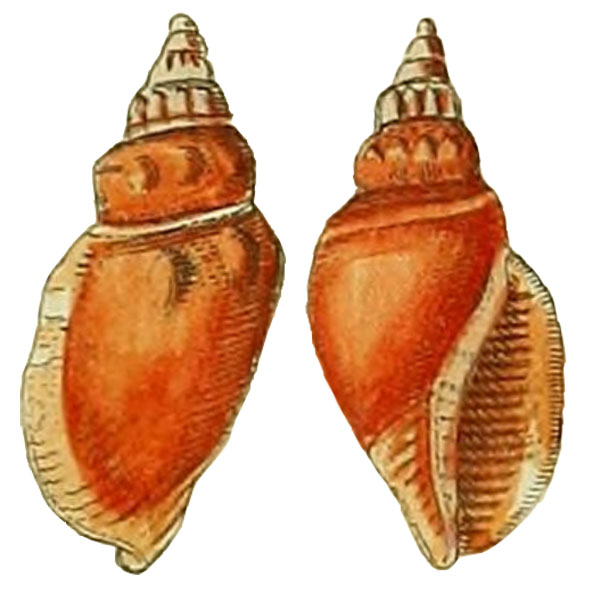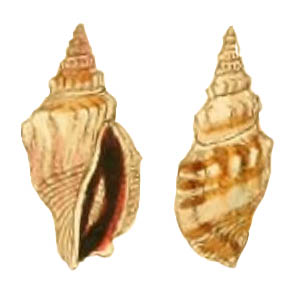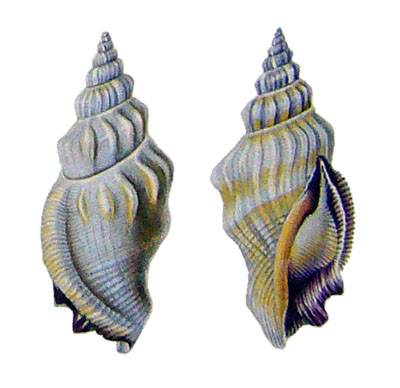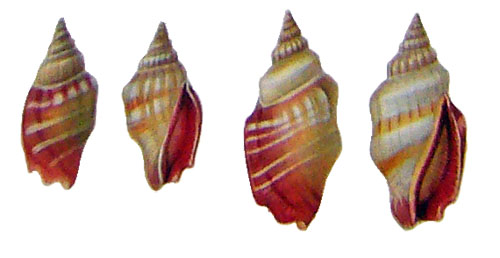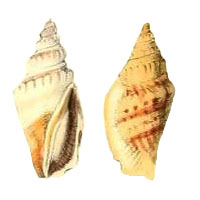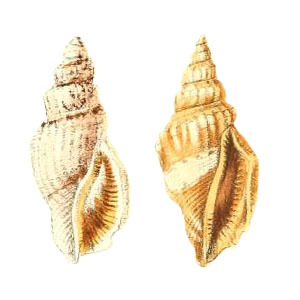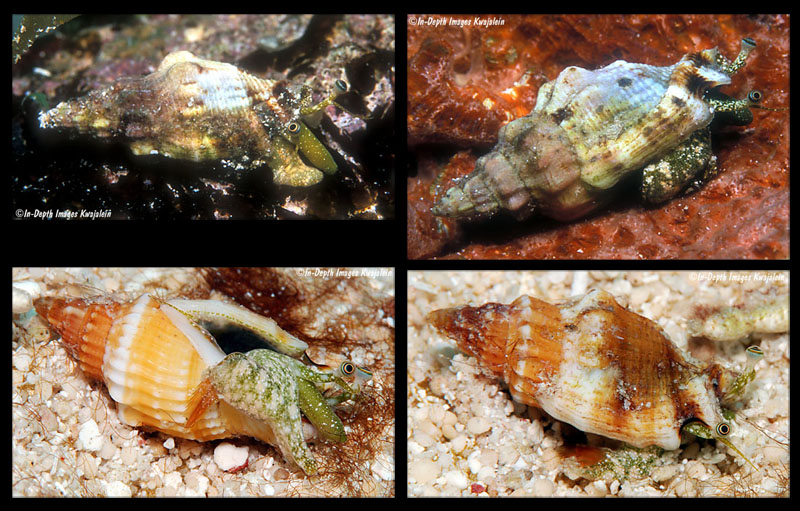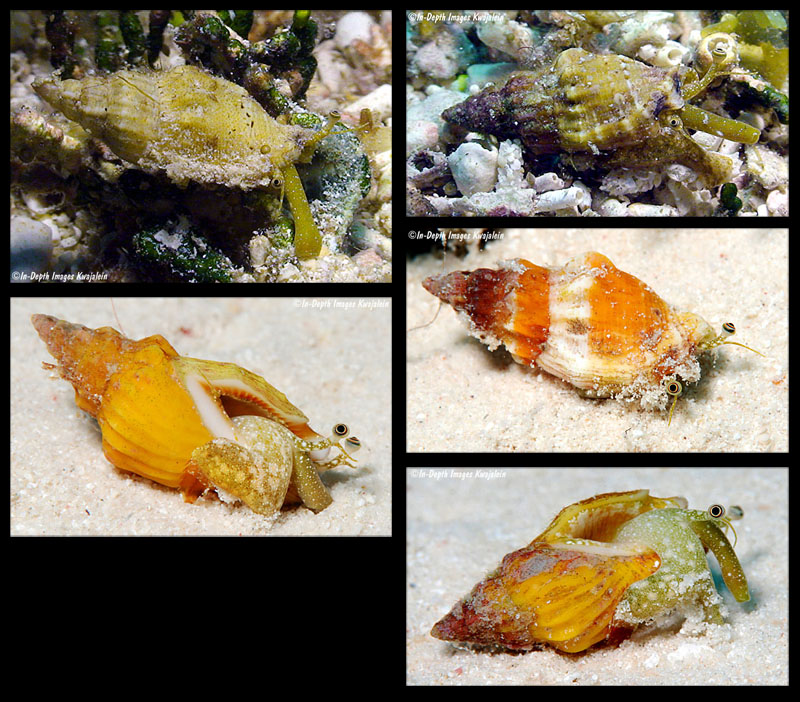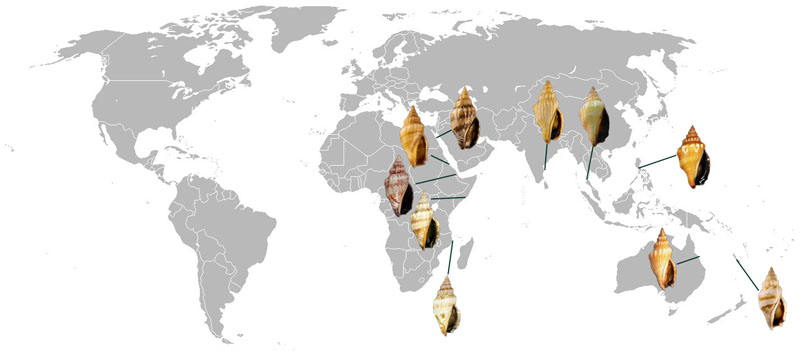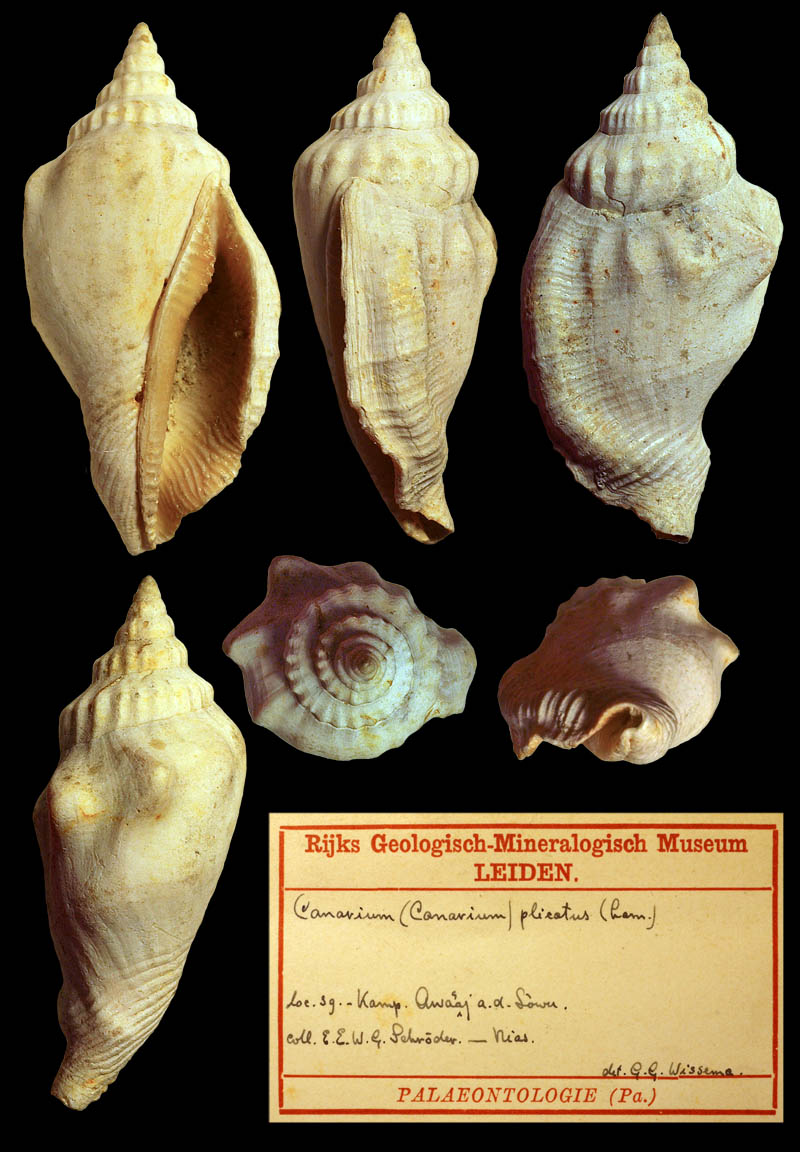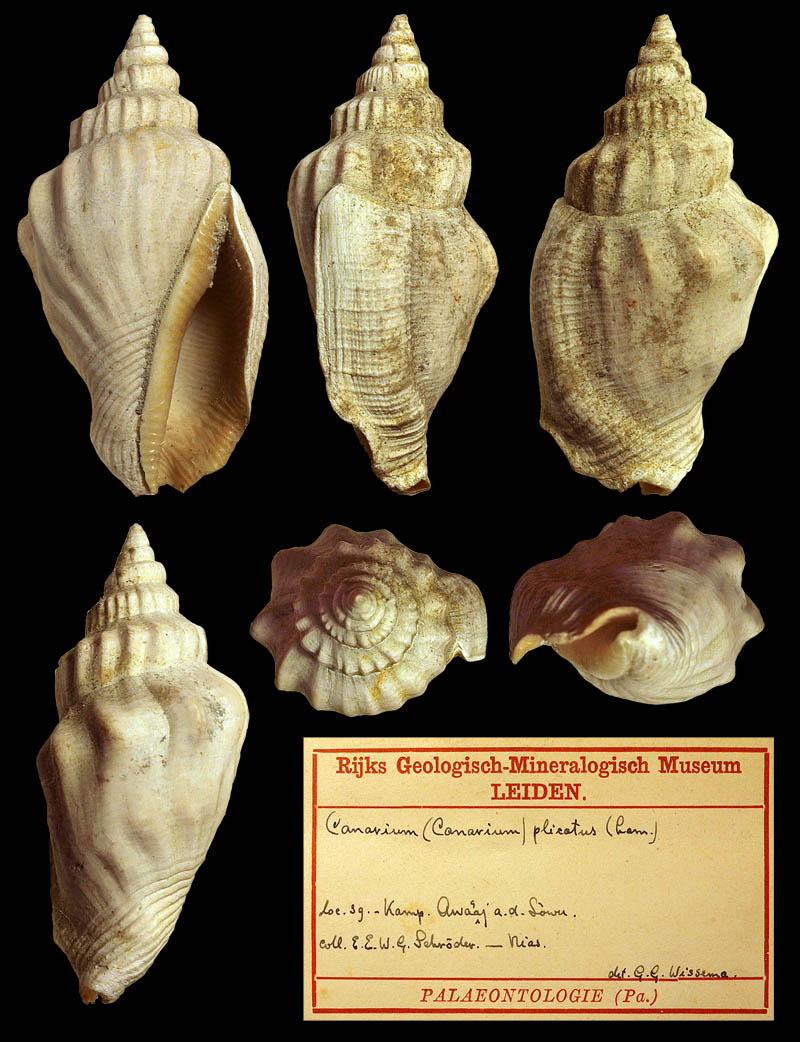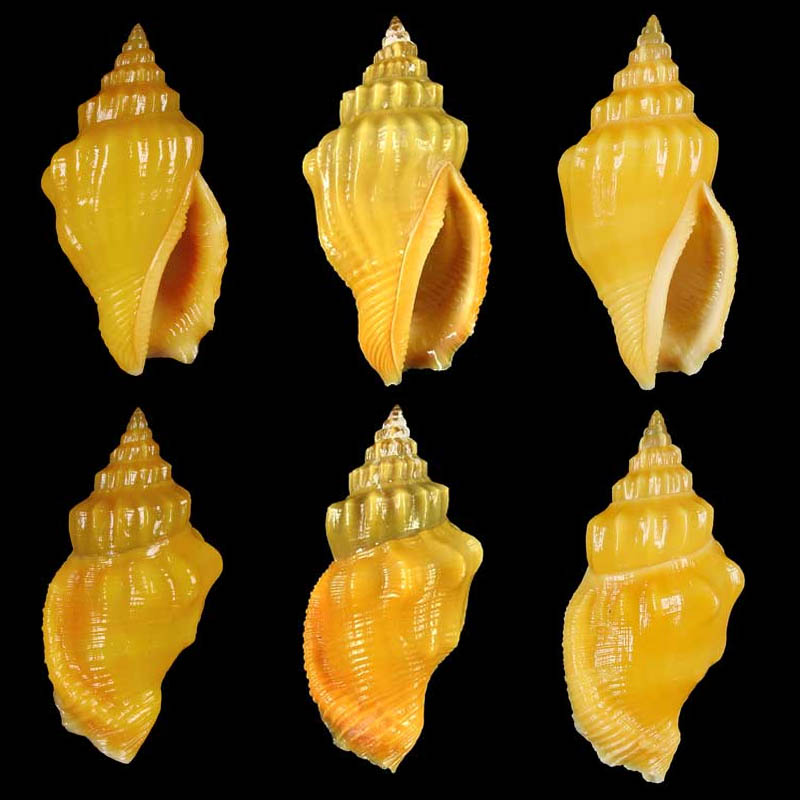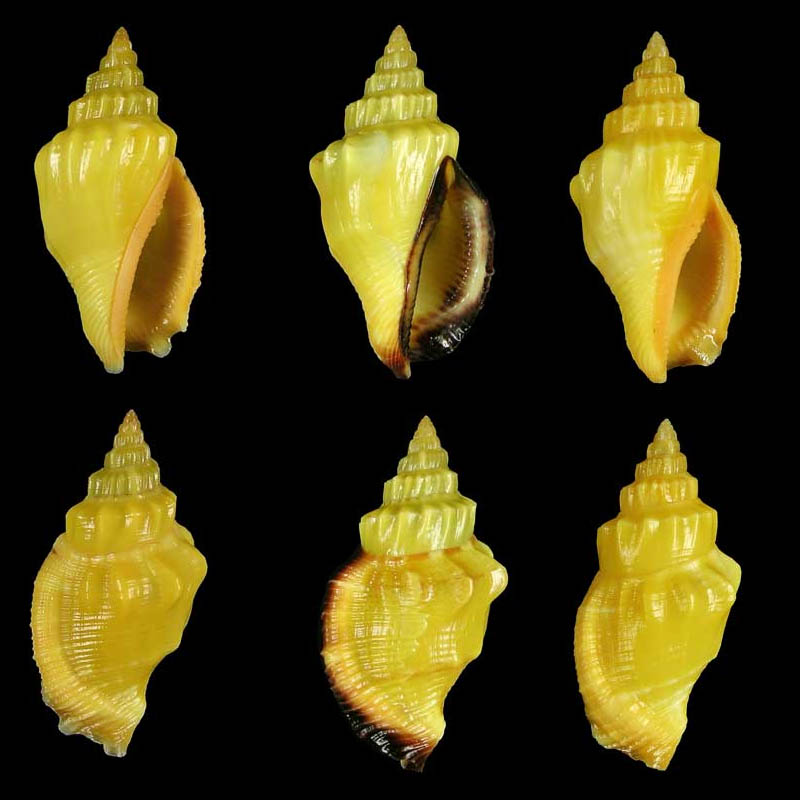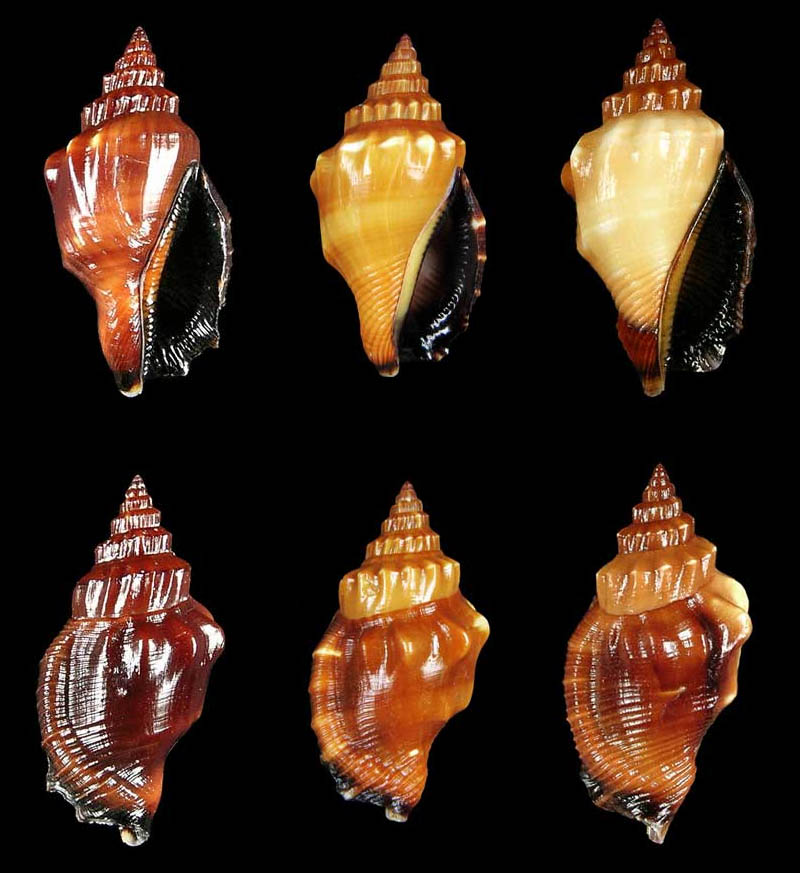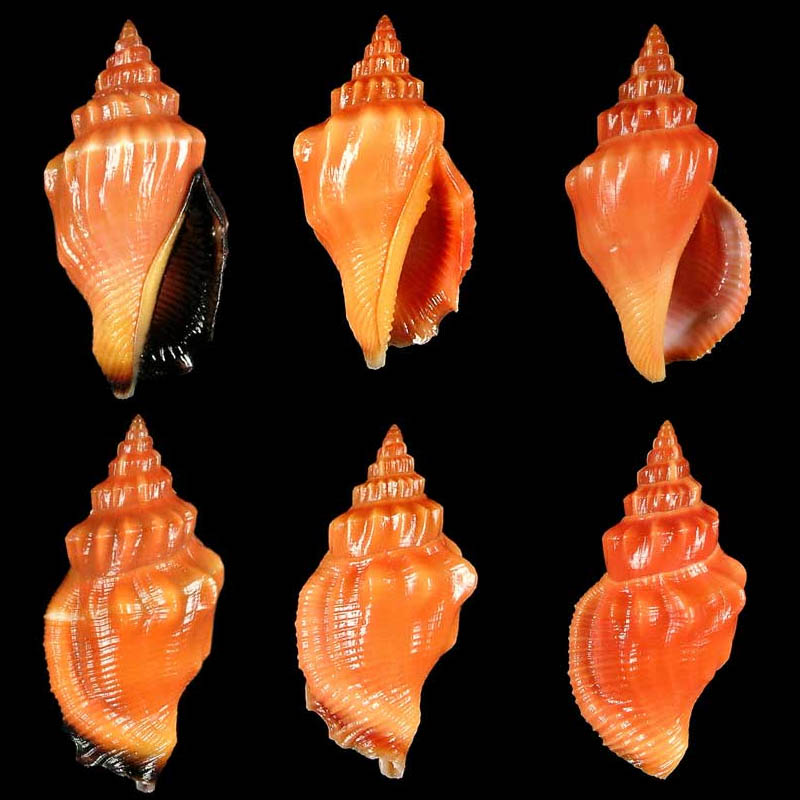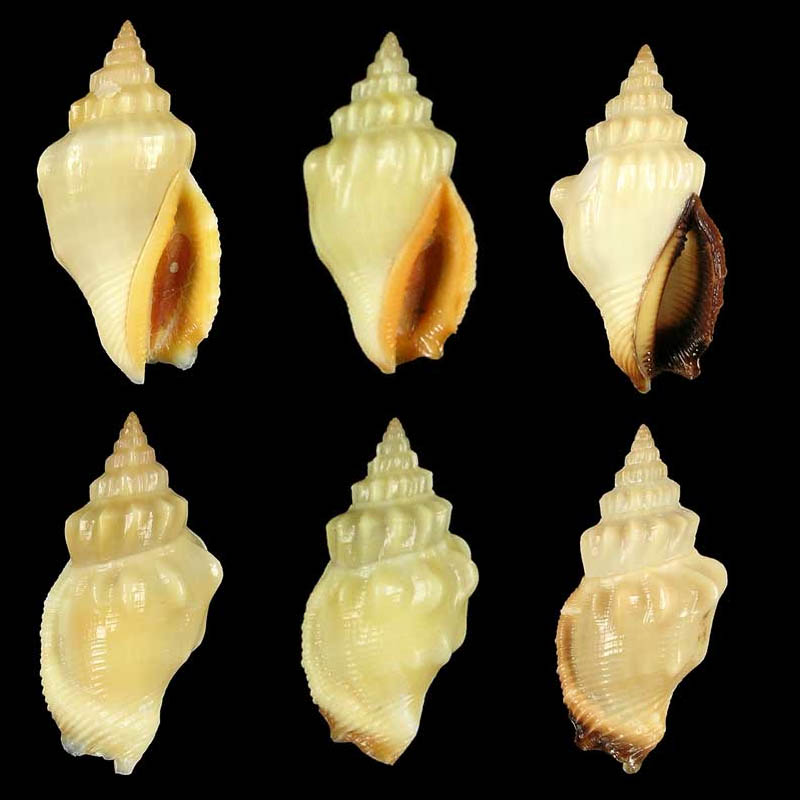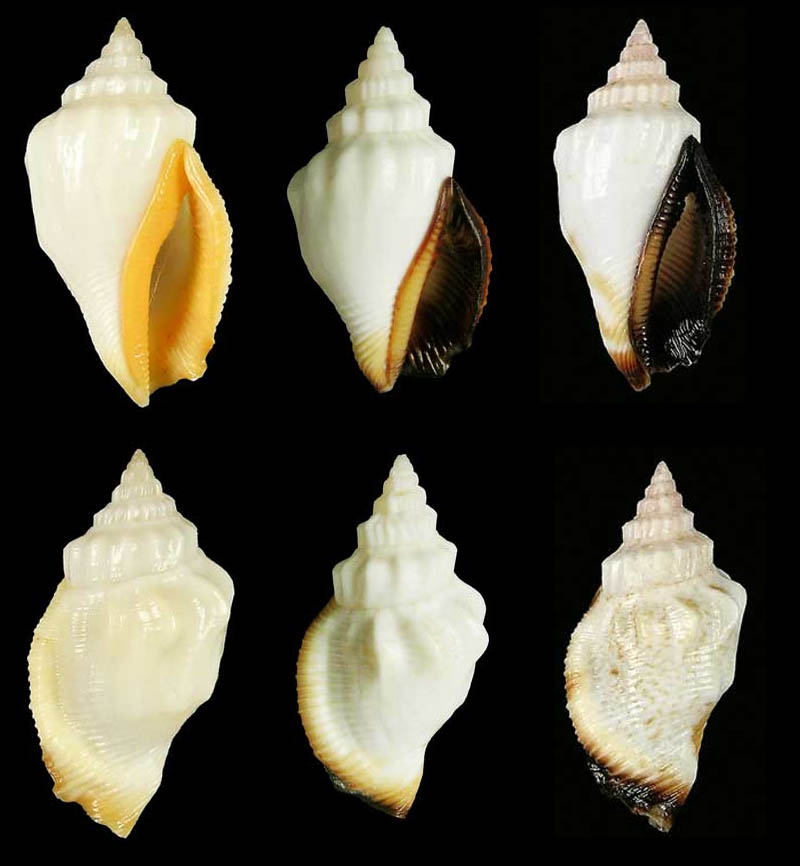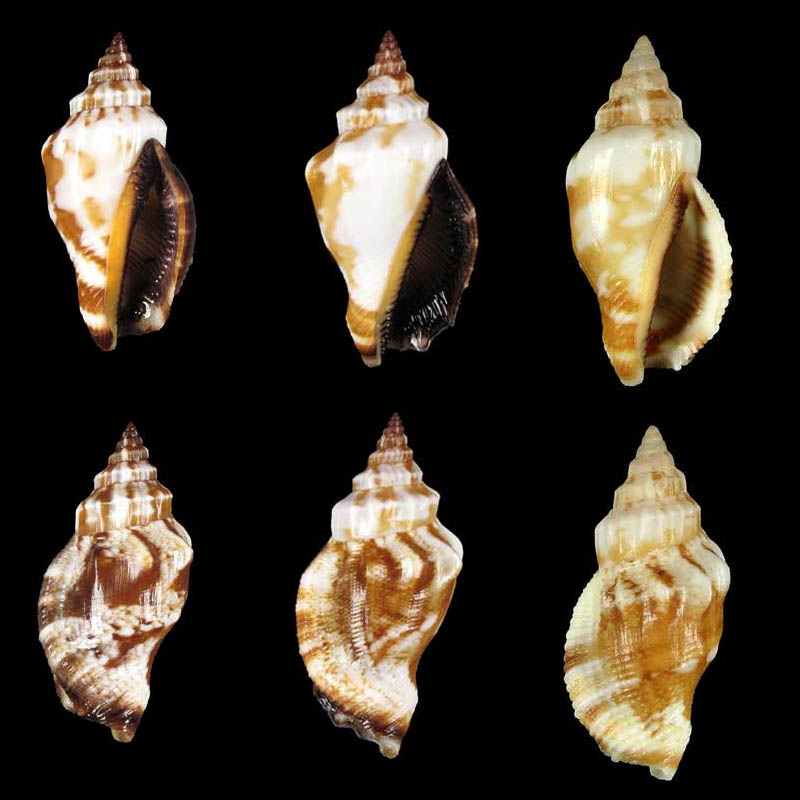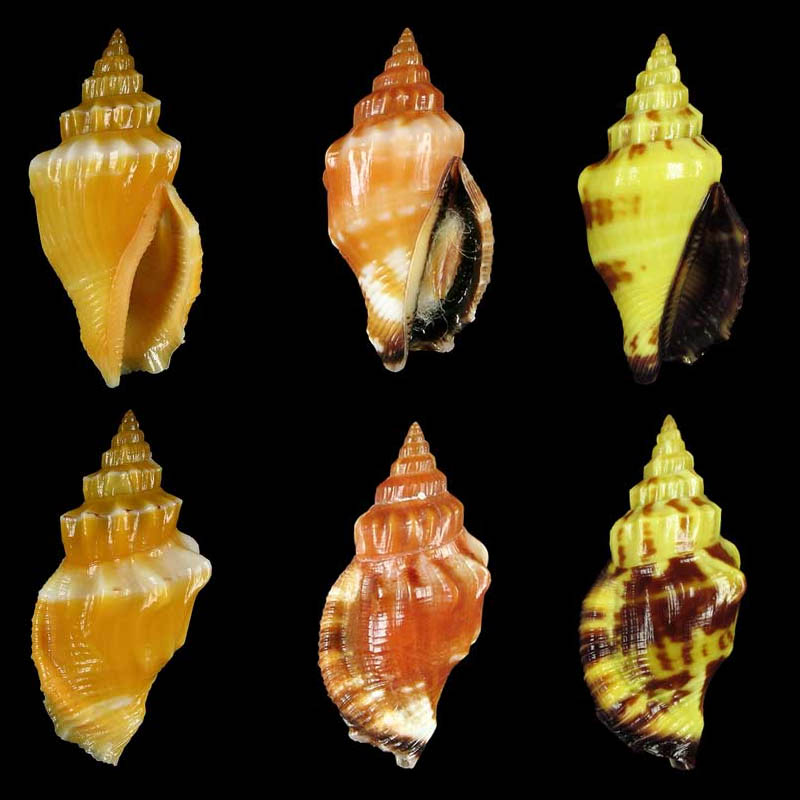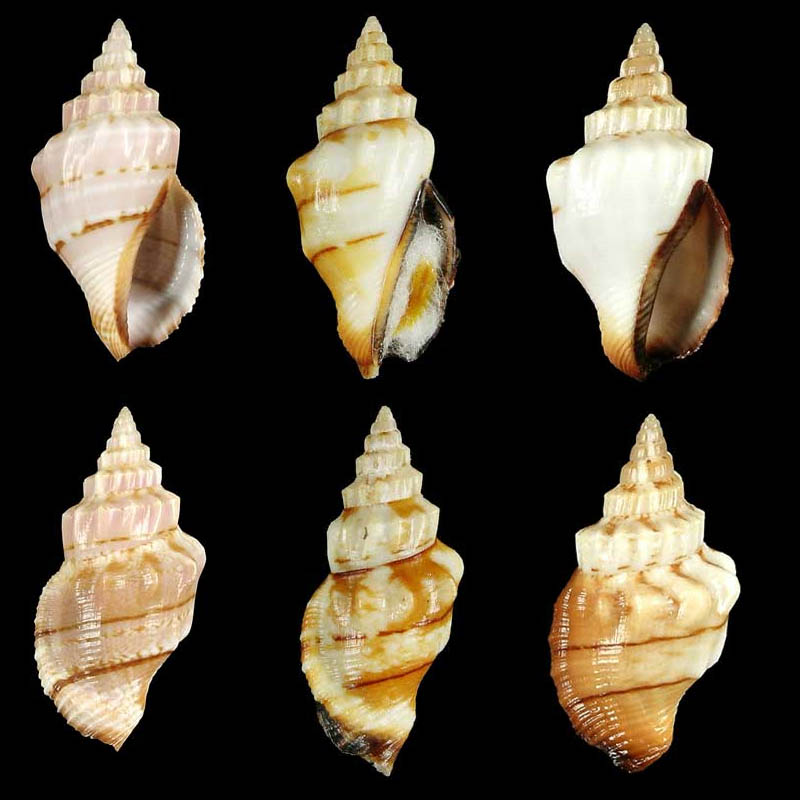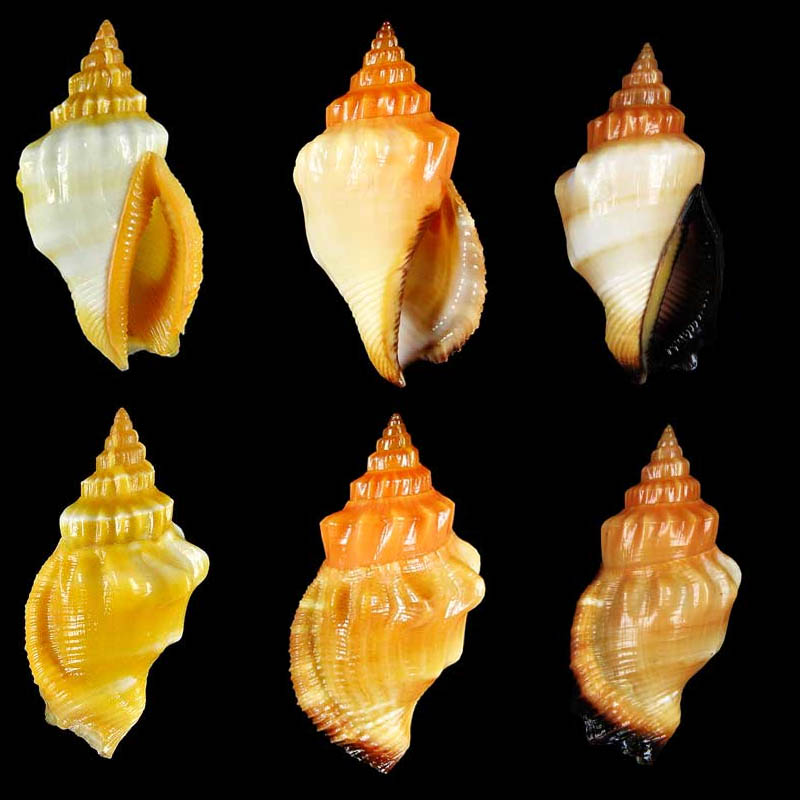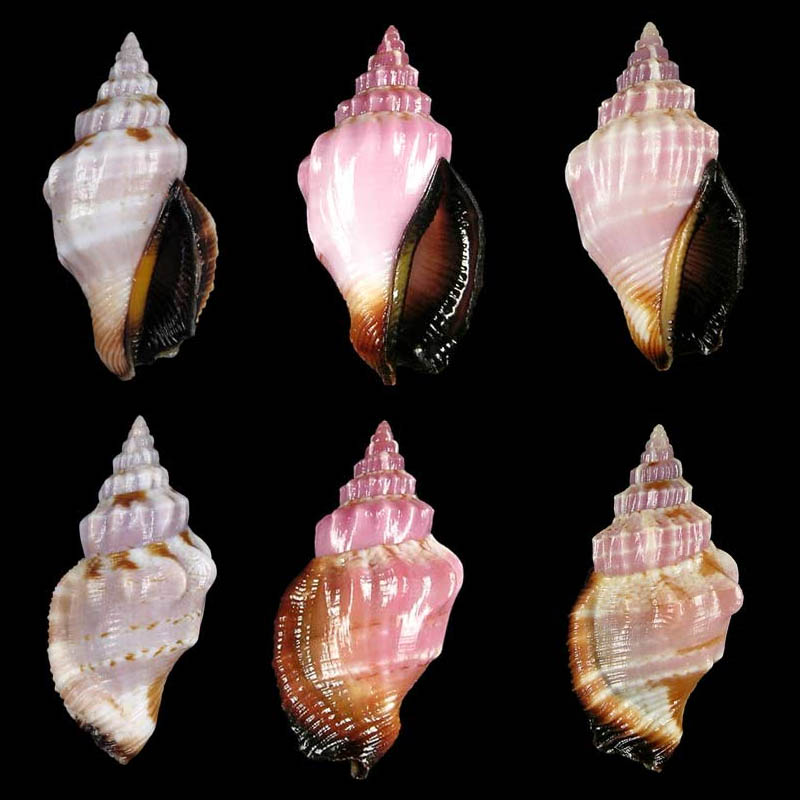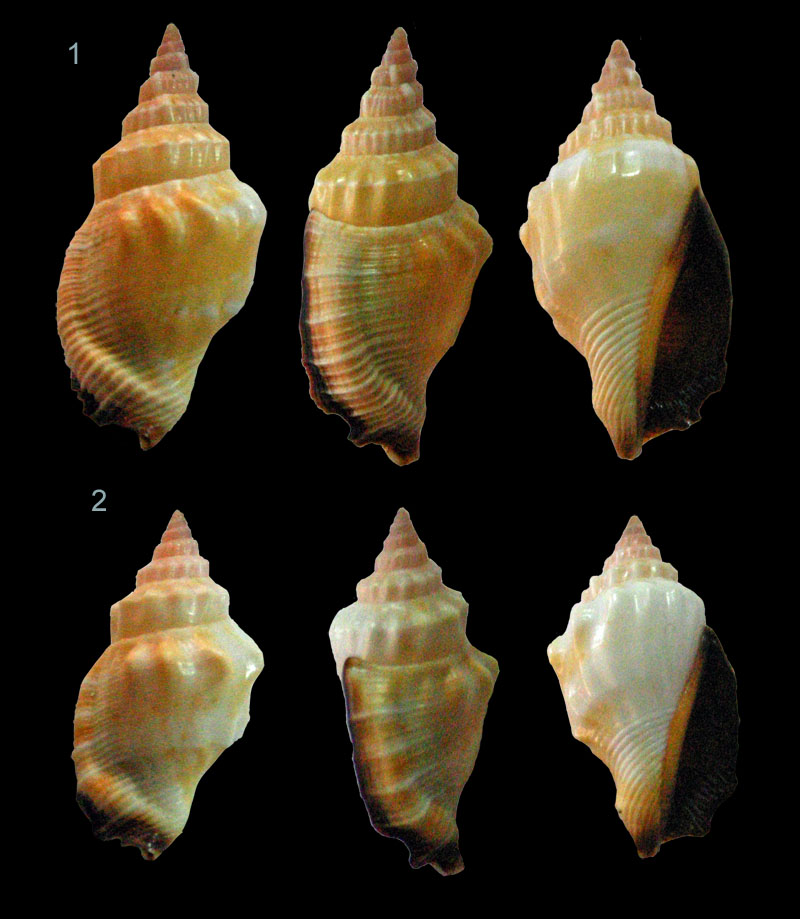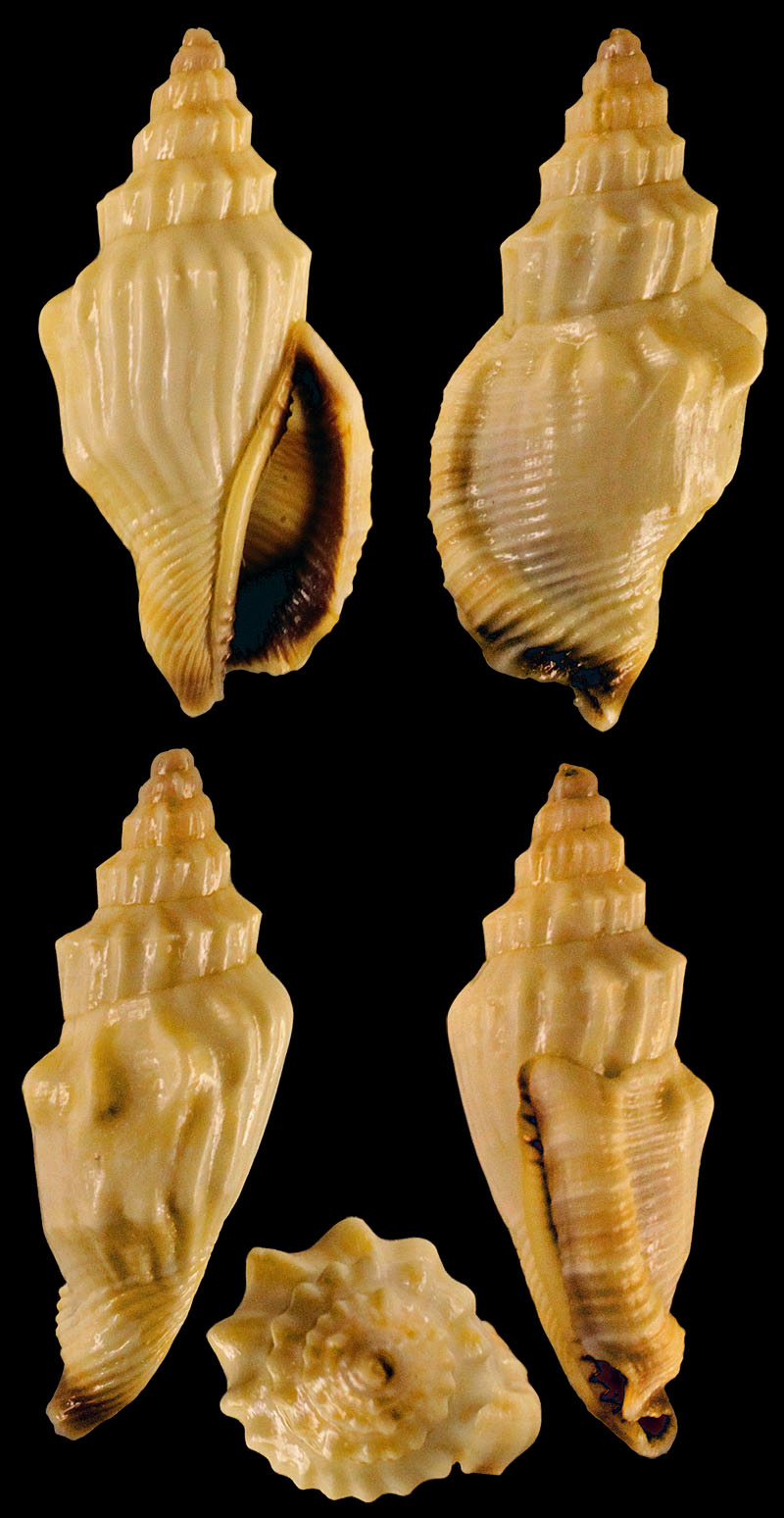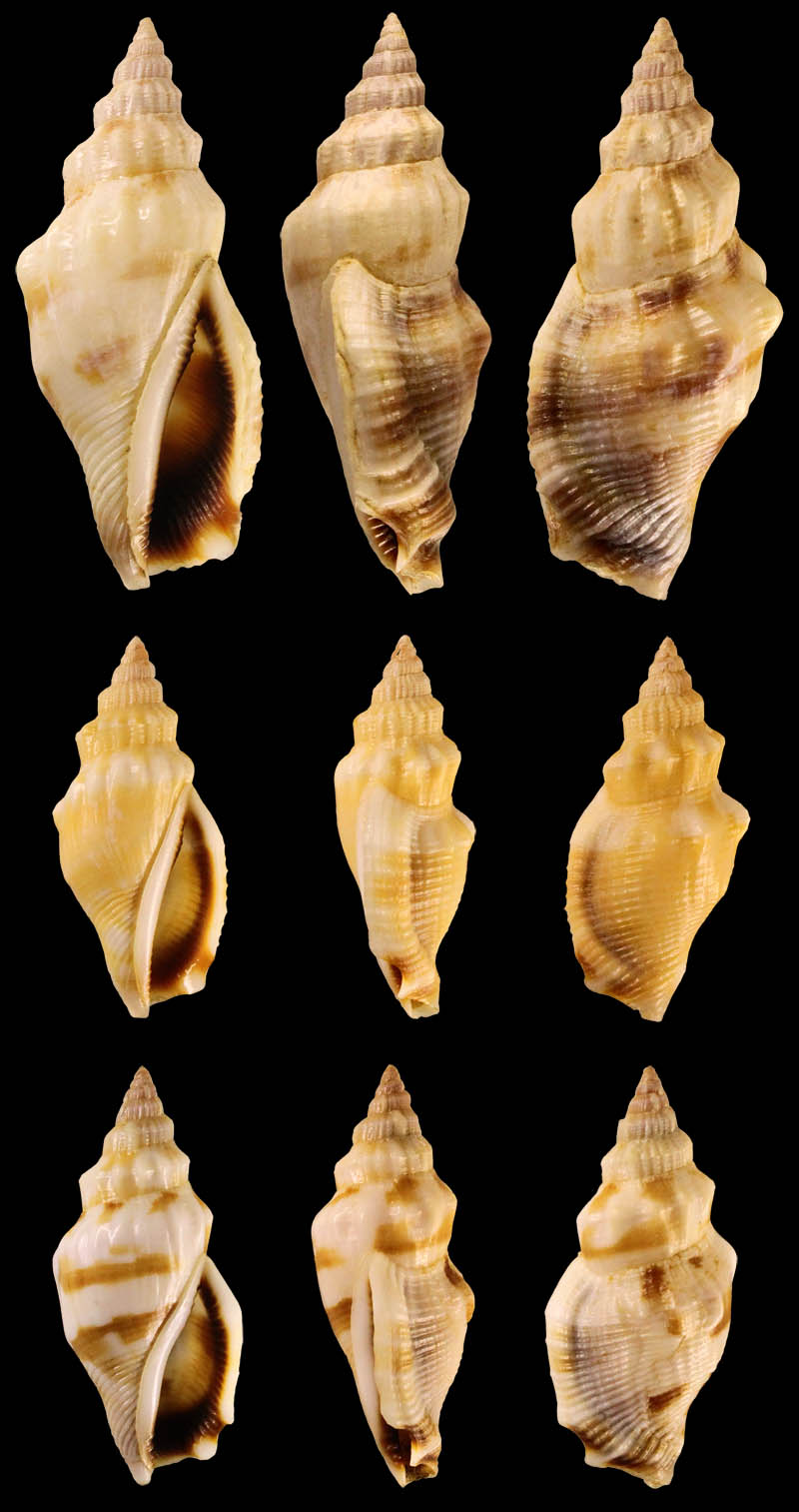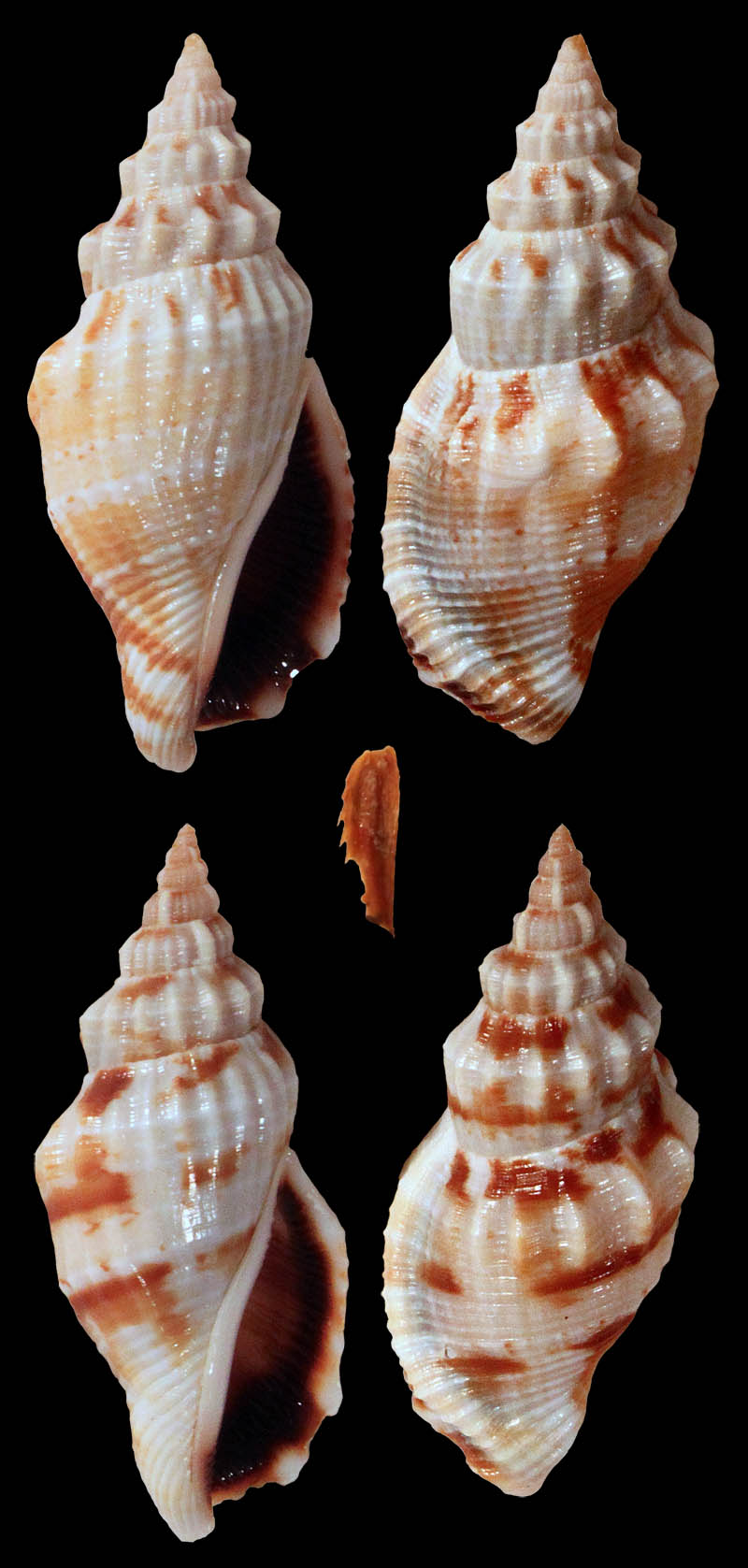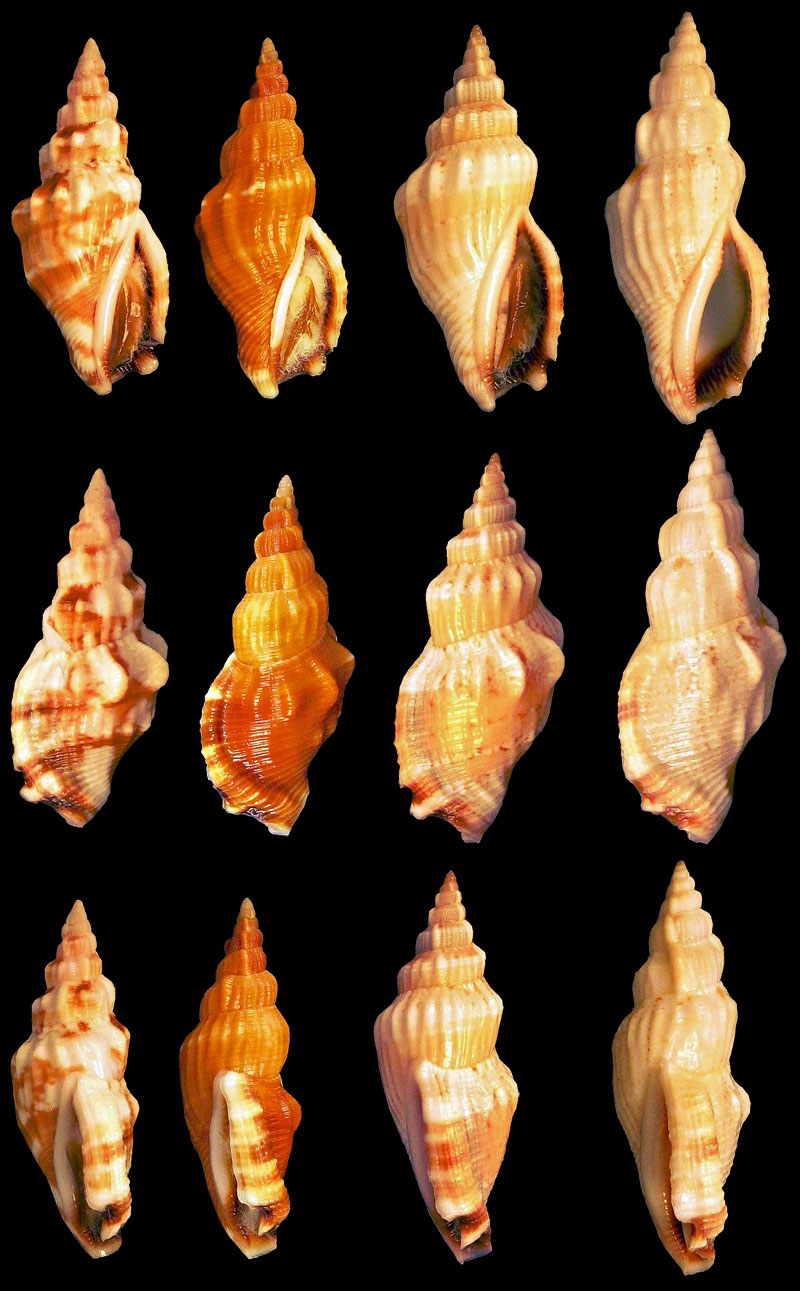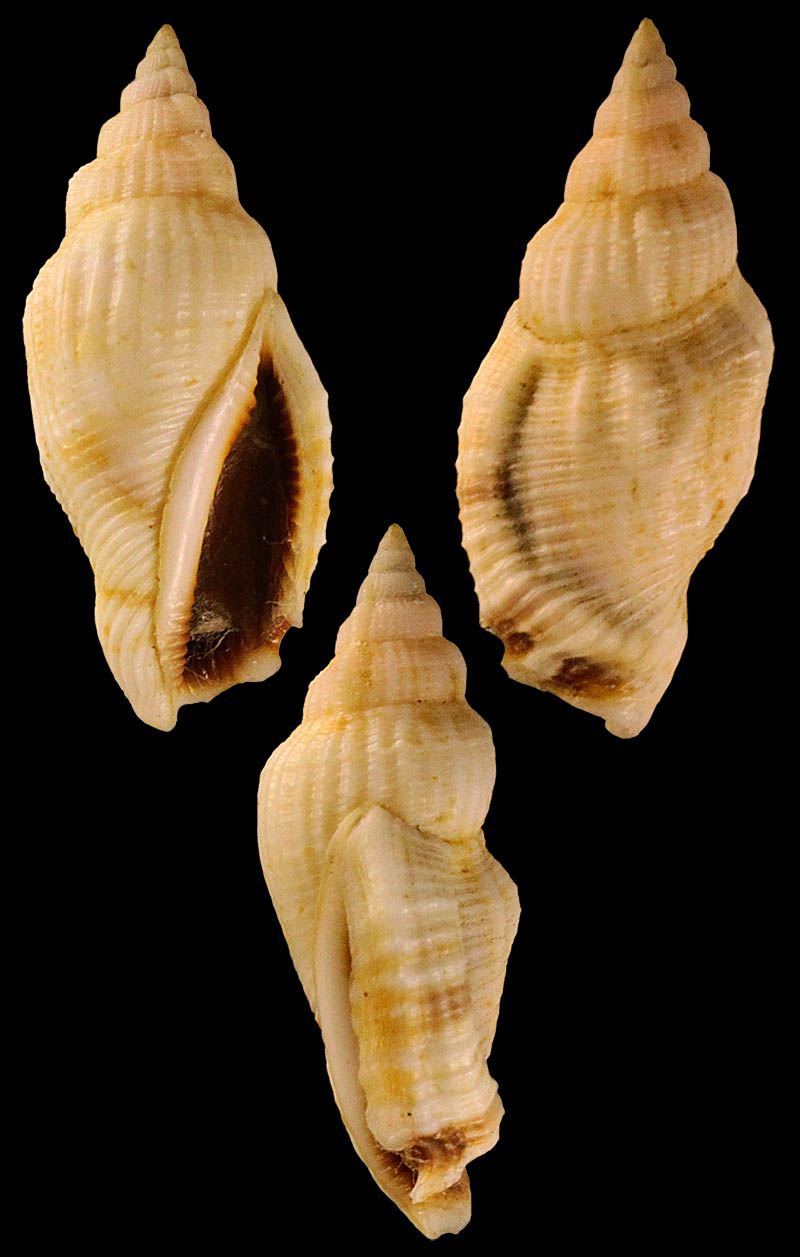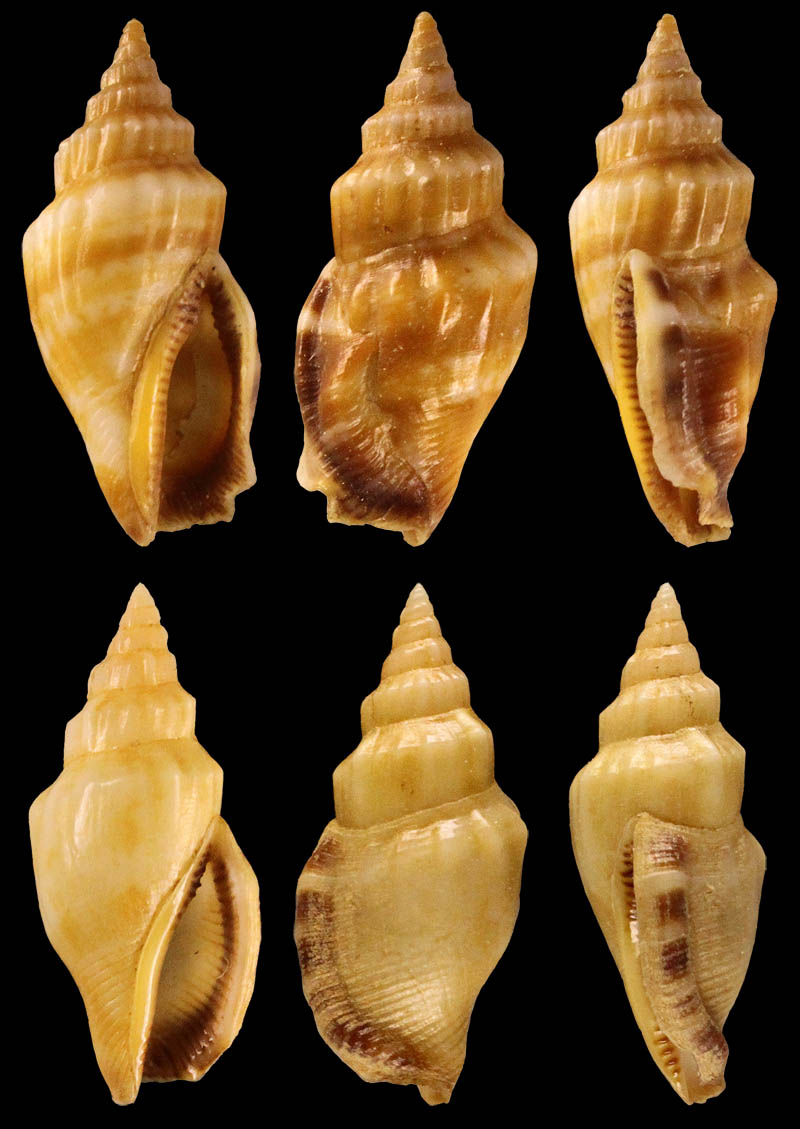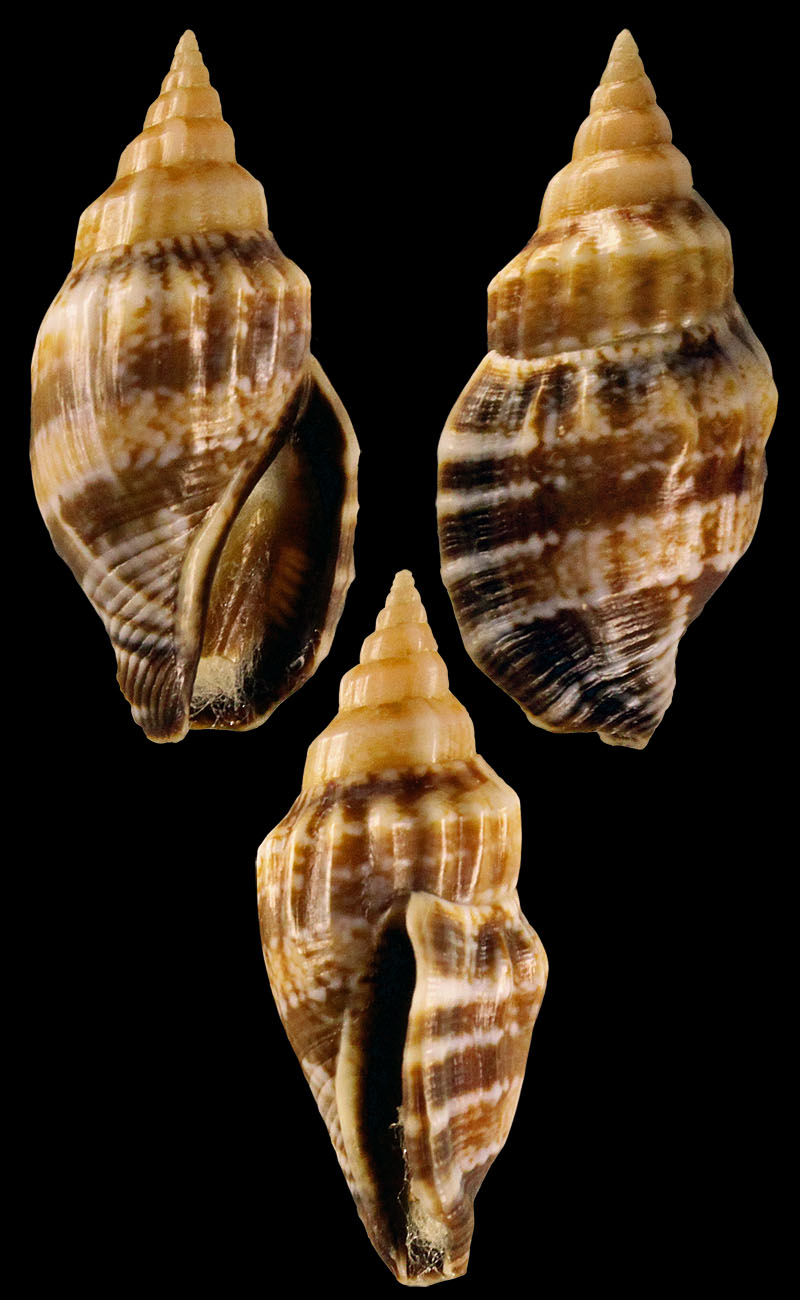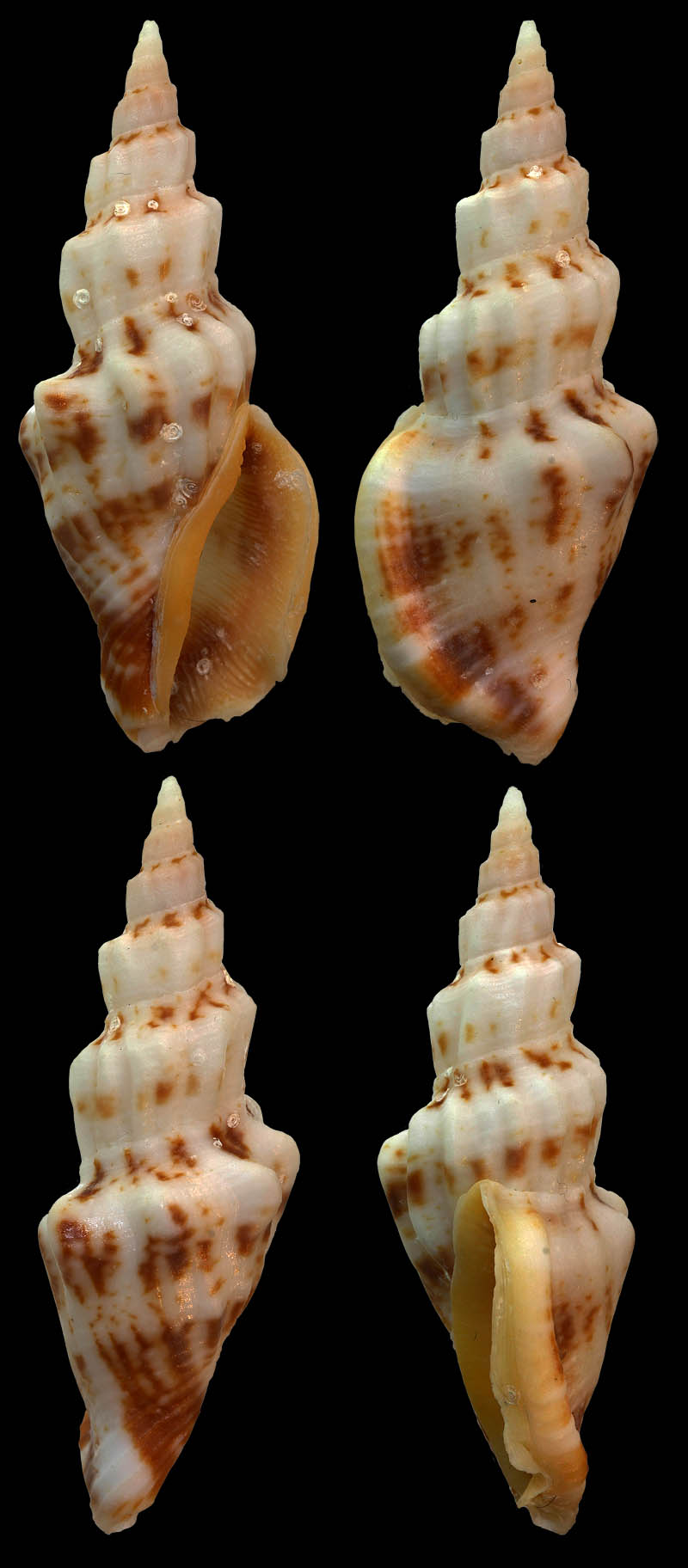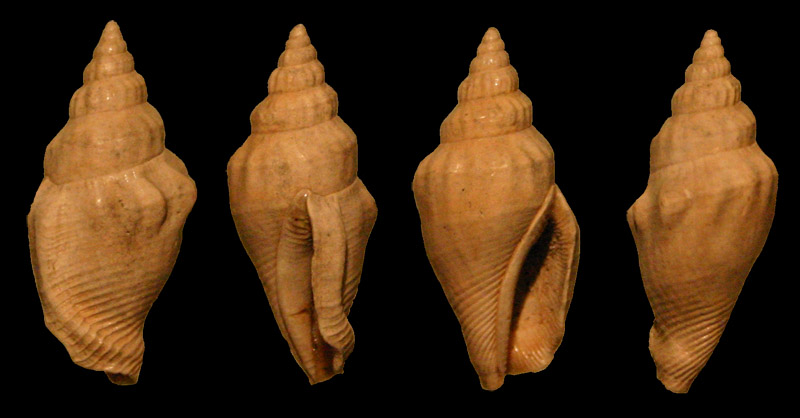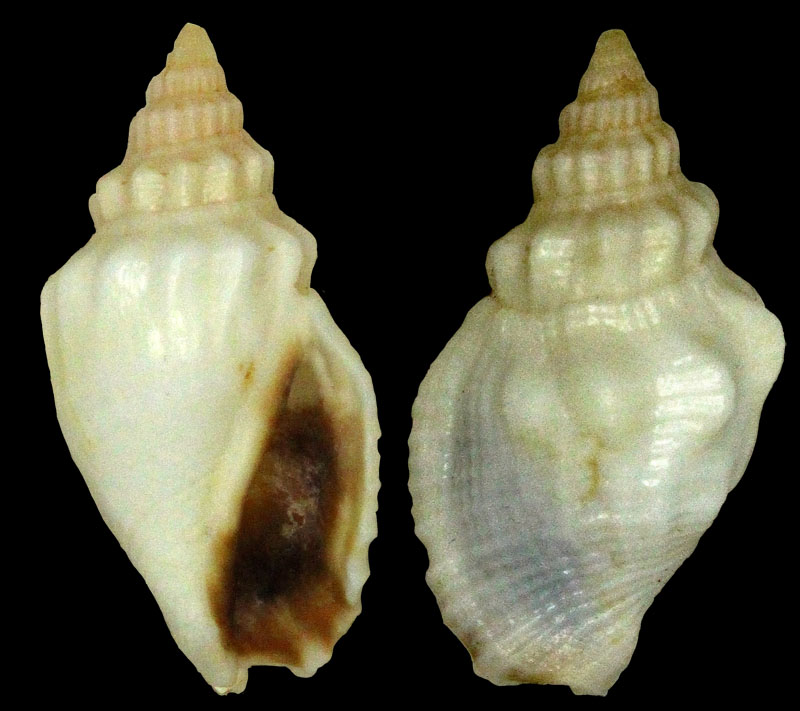|
edit SideBar
|
Species / Canarium Erythrinum
Stromboidea
Original Description of Strombus erythrinus by Dillwyn, 1817, p. 673:
- "Shell with nodulous plaits on the body-whorl and spire; outer lip striated on both sides, and the inner lip white and striated."
Locus typicus: "Inhabits the Red Sea. Chemnitz." (Dillwyn, 1817, p. 673); Red Sea (designated by Abbott, 1960)
Dillwyn, 1817, p. 673 cited:
- "Strombus Erythrinus. Chemnitz, xi. p. 146. t. 195. A. f. 1874 and 1875."
- "Shell about thirteen lines long and six broad, shining, reddish, and tinged with rose-colour; the inner lip is thickened, somewhat reflected, white, and striated at the base."
Strombus erythrinus Chemnitz, 1795, pl. 195 A, fig. 1874, 1875
History and Synonymy
Canarium erythrinum (Dillwyn, 1817: 673) (Strombus)
- Syn.: Strombus crassilabrum Anton, 1839: 87
- Syn.: Canarium dentatum L. var. erythinum Newton, 1900: 508-509.
- Syn.: Strombus elegans Sowerby2nd, 1842: 30, pl. 7 figs 43, 48
- Syn.: Strombus erythrensis Caramagna, 1888:115
- Syn.: Strombidea erythrinus Chemn. Jousseaume, 1888: 174 [in Muricidae]
- Syn.: Strombus (Canarium) erythrinus forma costulata Romagna-Manoja, 1980a: 15 [unavailable; published as a varietal name after 1960, ICZN art. 15.2]
- Syn.: Strombus (Canarium) erythrinus forma varicosa Romagna-Manoja, 1980a: 15 [unavailable; published as a varietal name after 1960, ICZN art. 15.2]
- ? Syn.: Strombus (Canarium) haemastoma Sowerby. Abrard, 1946: 62, pl. 4 fig. 29
- Syn.: Strombus (Canarium) plicatus Lamarck. Oostingh, 1925: 59-69 [partim] [non Strombus plicatus Lamarck, nec Lambis plicata Röding]
- Syn.: Strombus radians Duclos in Chenu, 1844: 5, pl. 4 figs 15, 16
- Syn.: Strombus ruppellii Reeve, 1850: pl. 8 figs 13a, b
1795
Chemnitz, 1795, p. 146:
- "Tab. 195. A. Fig. 1874. 1875. Ex Mus. Acad. Hafniensis"
- "Der Rotbart. Strombus Erythrinus, testa lucide rubicunda, quasi ex roseo infecta, dorso spiraque plicato nodulosis, labro fimbriato, intus et extus striato infra attenuato; labio adnato reflexo albido, basi striata."
- Wer jenen Strombum, der beym Linne Urceus heißt, ferner auch jenen, der von ihm dentatus genannt wird, kennen gelerntm der wird es gestehen müßen, daß diese hier vorgestellte kleine niedliche Schnecke in ihrer Form, Bildung und ganzen Bauart viele Gleichförmigkeit mit jenen habe, und ihnen nahe verwandt sey. Sie empfiehlt sich insonderheit durch ihr schönes, frisches, jugendliches, rosenrothes Farbenkleid, bey welchem doch hie und da ein weißer Hintergrund hervorblicket. Auf ihren sieben Stockwerken treten einige faltenartige Knotenreihen hervor. Die äußerliche Lippe hat einen breiten, beydes innerlich und äußerlich gestreiften und wie geriffelten Lippensaum. Die innere Spindellippe ist glatt und weiß. Der Bauch Bauch ist glatt und ermangelt aller Falten. Es wohnet diese rothe Schnecke am Strande des rothen Meeres. Sie scheinet freylich auf den Namen eines Strombi oder einer Flügelschnecke, keinen recht starken Anspruch machen zu können. Aber da doch ein in die Höhe gewundener Schalenbau, eine erweiterte Mündungslippe, und ein zur linken Seite hinüber gekehrter Canal, also testa spiralis, labrum ampliatum und canalis sinister bey ihr gesehen wird, so darf ihr niemand den ihr angewiesenen Standort streitig machen."
1839
Strombus crassilabrum Anton, 1839
- Description of Strombus crassilabrum in Anton, 1839, p.87:
- "2820. 1. crassilabrum mihi, spitz-oval, Gewinde ziemlich niedrig, 6 convexe Windungen, letzte grösser als die übrigen zusammen, mit 3 kielartigen, äusserst flachen Reifen, sonst quergestreift, Mundsaum und Basis gefurcht; Naht gerandet, obersten Windungen mit kleinen Tuberkeln besetzt; blassgelb; Mündung schmal, oben sehr spitz zugehend, quergestreift, innen roth, aussen weiss; Spindel mit dickem Wulst oben und unten gestreift, Mitte glatt, innen roth, äussrer Saum weiss; Mundsaum sehr stark, nicht gefügelt. Br. 7´´´ H. 1" 1´´´. Die convexe glatte vorletzte Windung und die gesäumten Nähte nähern sie dem St. gibberulus, die dicke, in der Mitte glatte Spindel dem St. urceus, das wenig hohe Gewinde dem St. floridus. Ein Verbindungsglied obiger drei Arten."
1842
Original Description of Strombus elegans by Sowerby2nd, 1842, p. 30
:
- "T. sub-elongata, fusiformi; spira sub-elongata, anfractibus angulatis, ad angulum plicatis, in medio minute tuberculatis, antice sulcatis; ultimi margine varicoso; apertura ovali, striata."
- "Much shorter in the body whorl than any of the three preceding [Strombus plicatus, Strombus rugosus, Strombus maculatus] species. It is of a pale brown, clouded in bands with darker brown; the aperture is striated and of a dark brown colour. It approaches S. rugosus in some characters, but is much more fusiform; the spire much larger in proportion to the aperture. One variety is nearly smooth."
Strombus elegans Sowerby2nd, 1842, pl. VII, fig. 43, 48
1844
Strombus radians, in Duclos in Chenu, 1844, pl. 4, fig. 15, 16
- Type Locality: Japan, designated by Abbott 1960
Strombus erythrinus in Duclos, 1844, pl. 5, fig. 16, 17, 18, 19
1850
Strombus ruppellii Reeve, 1850, Strombus, pl. 8, fig. 13 a, b
- Original Description of Strombus ruppellii by Reeve, 1850, pl. 8, Species 13:
- "Stromb. testa oblongo-fusiformi, spira acuminato-turrita, anfractibus superne concavo-depressis, subangulatis, ad angulum plicato-tuberculatis, tuberculis numerosis, anfracto ultimo pone labrum longitudinaliter costato et radiatim tenuilirato, columella incrassata, laminata, superne subtiliter corrugata, aperturae fazce corrugata; flavicante-alba, ustulato-fusco hic illic tincta et fasciata, labro purpureo-fusco, fasciis angustis albis radiato, columella et aperturae fauce intense purpureo-fuscis."
- "Shell oblong-fusiform, spire acuminately turreted, whorls concavely depressed round the upper part, slightly angled, plicately tubercled on the angle, tubercles numerous, last whorl ribbed longitudinally behind the lip and radiately finely ridged, columella thickened, laminated, finely wrinkled at the upper part, interior of the aperture wrinkled; yellowish-white, stained and banded here and there with burnt-brown, lip purple-brown, rayed with narrow white bands, columella and interior of the aperture rich purple-brown."
- Locus typicus: "Red Sea"
- "Image courtesy Biodiversity Heritage Library. http://www.biodiversitylibrary.org"
1851
Strombus elegans in Reeve, 1851, Strombus, pl. 17, fig. 41 a, b
1888
Original Text of Strombus erythrensis by Caramagna, 1888, p. 115:
- S. erythrensis. Chemnitz. Assab. Ovunque, ma rari gli esemplari belli, essendo per lo piu invasi dai paguri."
1995
Cook, 1995, p. 1:
- "There were also no Hawaiian Strombus erythrinus in the Bishop Museum collection."
Cook, 1995, p. 5:
- "I can find no record of a living Strombus erythrinus found in Hawaii. Cliff Weaver in his Hawaiian Marine Mollusks, May 1965, stated: "Although the range of Strombus erythrinus erythrinus Dillwyn, 1817 was reported as extending to Hawaii (Abbott, 1960), that record was based on a single subfossil specimen dredged at Pokai Bay, Oahu and therefore is not included in this report on living species. A tru fossil erythrinus collected by Dr. C.M. Burgess in a limestone formation at Kahi Park, Nanakuli, Oahu establishes this species in Hawaii's Pleistocene." (figure 4) After considerable research, I am convinced that the Burgess shell dredged by the R/V Pele in 1959 (figure 2) is not a crabbed "Strombus erythrinus" (or a subfossil "S. erythrinus") but is Strombus wilsoni Abbott, 1967. I am convinced that the fossil (figure 4) is also Strombus wilsoni and that Strombus erythrinus has never been found in Hawaii."
Reports
Jeanette and Scott Johnson on Canarium erythrinum from Kwajalein Atoll:
- "Canarium erythrinum is sporadically common in the Marshalls, usually being limited to specific habitats. Nearly all specimens are found hiding among algae stalks in lagoon Halimeda beds. We know about three algae beds where they are common, but they are almost absent elsewhere, and are never found on the seaward reef. Several broken shells and dead specimens were found cemented into carrier shells of the genus Xenophora found in a Halimeda bed on the lagoon bottom of Enewetak Atoll at a depth of about 60m in 1982, so perhaps they are also common in some deeper water lagoon bottom Halimeda patches. The shell comes in a variety of colors and ranges up to about 35mm in length. The photos below show just a few of the color forms."
All Photos of Kwajalein Atoll-specimens courtesy Scott & Jeanette Johnson, Kwajalein Atoll
Distribution of Canarium erythrinum
Specimens from institutional collections
Canarium (Canarium) plicatus (Dillwyn, 1817); Plio/Pleistocene; Nias Island, North Sumatra Province, Indonesia; Coll. Naturalis, Leiden
Canarium (Canarium) plicatus (Dillwyn, 1817); Plio/Pleistocene; Nias Island, North Sumatra Province, Indonesia; Coll. Naturalis, Leiden
Specimens from private collections
Canarium erythrinum (Dillwyn, 1817); Philippines Islands; Coll. Guido Poppe
- l: Palawan Island, Palawan Province, Mimaropa Region; 10-25 m; 2013; 33,7 mm; no. 779030
- m: Masbate Island, Masbate Province, Bicol Region; 10-25 m; 2010; 35,3 mm; no. 576183
- r: Olango Island, Cebu Province, Central Visayas Region; 10-25 m; collected by local fishermen; 2009; 35,5 mm; no. 553473
Canarium erythrinum (Dillwyn, 1817); Philippines Islands; Coll. Guido Poppe
- l: Olango Island, Cebu Province, Central Visayas Region; dived 15-30 m; collected by local fishermen; 2009; 28,9 mm; no. 527556
- m: Balabac Island, southern Palawan Province, Mimaropa Region; fished by fishermen from Olango Island; 2011; 27,0 mm; no. 645566
- r: Balabac Island, southern Palawan Province, Mimaropa Region; fished by fishermen from Olango Island; 2011; 28,4 mm; no. 645569
Canarium erythrinum (Dillwyn, 1817); Philippines Islands; Coll. Guido Poppe
- l: Olango Island, Cebu Province, Central Visayas Region; taken at 20-25 meters deep water during night dive; 30,1 mm; 2007; no. 416127
- m: Olango Island, Cebu Province, Central Visayas Region; 10-25 m; 31,3 mm; 2013; no. 790426
- r: Palawan Island, Palawan Province, Mimaropa Region; dived about 25 m; from local fishermen; 2006; no. 361919
Canarium erythrinum (Dillwyn, 1817); Philippines Islands; Coll. Guido Poppe
- l: Palawan Island, Palawan Province, Mimaropa Region; dived about 25 m, from local fishermen; 2006; 30,5 mm; no. 361918
- m: Olango Island, Cebu Province, Central Visayas Region; taken 20-25 meters deep during nightdive; 2007; 26,2 mm; no. 380856
- r: slightly subadult; Cawoi Island, Olango Island Group, Cebu Province, Central Visayas Region; collected by local fishermen; 2008; 28,8 mm; no. 463787
Canarium erythrinum (Dillwyn, 1817); Philippines Islands; Coll. Guido Poppe
- l: Masbate Island, Masbate Province, Bicol Region; collected from local fishermen; 2006; 31,7 mm; no. 588052
- m: Masbate Island, Masbate Province, Bicol Region; collected from local fishermen; 2006; 29 mm; no. 462415
- r: Masbate Island, Masbate Province, Bicol Region; collected from local fishermen; 2006; 30,7 mm; no. 588049
Canarium erythrinum (Dillwyn, 1817); Philippines Islands; Coll. Guido Poppe
- l: Olango Island, Cebu Province, Central Visayas Region; 10-25 m; 28 mm; 2011; no. 623291
- m: Olango Island, Cebu Province, Central Visayas Region; taken 20-25 m; during nightdive; 27,9 mm; 2004; no. 590012
- r: Nocnocan Island; found at 20 meters deep water; 31,4 mm; May 2008; no. 456783
Canarium erythrinum (Dillwyn, 1817); Philippines Islands; Coll. Guido Poppe
- l: Andol Point, Olango Island, Cebu Province, Central Visayas Region; dived 10-18 m; 2013; 27 mm; no. 807524
- m: Andol Point, Olango Island, Cebu Province, Central Visayas Region; dived 10-18 m; 2013; 30,1 mm; no. 807520
- r: Balabac Island, southern Palawan Province, Mimaropa Region; dived at about 25 m depth by fishermen from Olango Island; 2006; 23 mm; no. 327114
Canarium erythrinum (Dillwyn, 1817); Philippines Islands; Coll. Guido Poppe
- l: Olango Island, Cebu Province, Central Visayas Region; dived 15-30 m; collected by local fishermen; 2009; 32,2 mm; no. 527560
- m: Olango Island, Cebu Province, Central Visayas Region; 10-25 m; collected by local fishermen; 2010; 30,0 mm; no. 575752
- r: Zamboanga, Mindanao Island, Zamboanga Peninsula Region; 10-25 m; 2013; 31,0 mm; no. 776589
Canarium erythrinum (Dillwyn, 1817); Philippines Islands; Coll. Guido Poppe
- l: Olango Island, Cebu Province, Central Visayas Region; 10-25 m; collected by local fishermen; 2009; 30,8 mm; no. 587573
- m: Olango Island, Cebu Province, Central Visayas Region; taken 20-25 m during nightdive; 2007; 30,4 mm; no. 395767
- r: Pandanan Island; Scuba dived at 19 meters deep water; 7/2007; 19,9 mm; no. 402766
Canarium erythrinum (Dillwyn, 1817); Philippines Islands; Coll. Guido Poppe
- l: Santa Rosa, Cawoi Island, Olango Island Group, Cebu Province, Central Visayas Region; from fishermen; 4/2005; 29,5 mm; no. 253298
- m: Olango Island, Cebu Province, Central Visayas Region; 10-35 m; collected by local fishermen; 2010; 31,8 mm; no. 573565
- r: Olango Island, Cebu Province, Central Visayas Region; 10-25 m; 2013; 29,0 mm; no. 790430
Canarium erythrinum (Dillwyn, 1817); Philippines Islands; Coll. Guido Poppe
- l: Andol Point, Olango Island, Cebu Province, Central Visayas Region; dived 10-18 m; 2013; 35,7 mm; no. 813455
- m: Cawoi Island, Olango Island Group, Cebu Province, Central Visayas Region; taken at about 20-25 meters deep water during night dive; 2007; 27,6 mm; no. 407543
- r: Olango Island, Cebu Province, Central Visayas Region; trawled by local fishermen at about 10-25 meters deep water; 2006; 26.6 mm; no. 387772
Canarium erythrinum (Dillwyn, 1817); Racha Islands (Raya), southeastern coast of Phuket, Thailand, Andaman Sea; 2004; Coll. René Vanwalleghem
- 35 mm
- 29 mm
Canarium erythrinum (Dillwyn, 1817); Cuddalore, Cuddalore district, Tamil Nadu State, Southern India; trawled by fishermen; 1998; 29,1 mm; Coll. Frank Nolf no. 05897e
Canarium erythrinum (Dillwyn, 1817); Noumea, South Province, New Caledonia, Melanesia; in sand on reef; in 2 m; 6/1969; t: 41,1 mm, m: 27,6 mm, b: 30,4 mm; Coll. Frank Nolf no. 05897a
Canarium erythrinum (Dillwyn, 1817); Ricaudy, Noumea, South Province, New Caledonia, Melanesia; both 45 mm; by local shell collector; 9/2004; Coll. Christian Boernke
Canarium erythrinum (Dillwyn, 1817); Queensland State, north east Australia; Coll. Paul Merrill
- 1.c: Swains Reef; big sandy reef, dredged in sand 3-5 m; 34,0 mm
- 2.c: Swains Reef; big sandy reef, dredged in sand 3-5 m; 34,3 mm
- 3.c: Swains Reef; big sandy reef, dredged in sand 3-5 m; 37,0 mm
- 4.c: Lady Musgrave Island; on rubble at low tide; 44,5 mm
Canarium erythrinum (Dillwyn, 1817); off Cooktown, Queensland State, north east Australia; 31,2 mm; Coll. Frank Nolf no. 05897b
Canarium erythrinum (Dillwyn, 1817); Dahlak, Ethiopia; among madrepora, at 2 m; t: 26,5 mm, b: 26,0 mm; Coll. Frank Nolf no. 05897
Canarium erythrinum (Dillwyn, 1817); Safaga, Egypt; on sand, dived at 0,5 m; 2/1997; 31,0 mm; Coll. Frank Nolf no. 05897d
Canarium erythrinum (Dillwyn, 1817); Djibouti, Gulf of Aden, Arabian Sea; on sand; 1.r: 30 mm, 2.r: 29 mm, 3.r 29 mm, 4.r: 28 mm, 5.r: 27 mm; Coll. Christian Börnke
Canarium cf. erythrinum (Dillwyn, 1817); Olango Island, Cebu Province, Central Visayas Region, Philippines; dived in 50 m; 46 mm; 11/2011; Coll. Ulrich Wieneke
Canarium erythrinum (Dillwyn, 1817); upper Pliocene; "Solo River", Sangiran, Java Island, Indonesia; 30,0 mm; Coll. Elmar Mai
Canarium elegans x labiatum; Kouare Pass, Kouare Island, South Province, New Caledonia, Melanesia; dived alive in 2003 at 25-40 m on sand seagrass; 25 mm; Coll. Ulrich Wieneke
References
- Abbott, 1960
- Anton, H. E. 1839. Verzeichniss der Conchylien welche sich in der Sammlung von Hermann Eduard Anton befinden. - pp. I-XVI [= 1-16], 1-110. Halle. (Anton), Fulltext.
- According to Cernohorsky (1978: 299), the publication of Anton was issued "around the middle of the year, 1838".
- Cernohorsky, W. O. (1978): The date of publication of Anton's "Verzeichnis der Conchylien". – The Veliger 20(3):299, Fulltext
- Caramagna, 1888
- B. Cook, 1995. Proposed Name Change for Hawaiian Strombus Records, Hawaiian Shell News vol. XLIII (6), p. 1,5-6, Fulltext
- Dillwyn, 1817 (Google Books)
|

